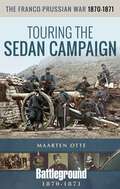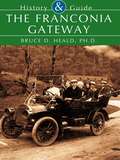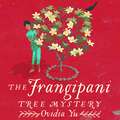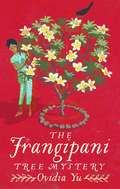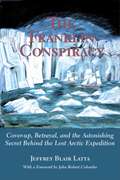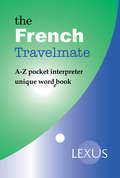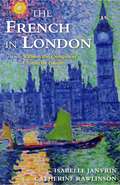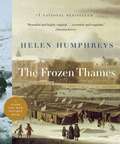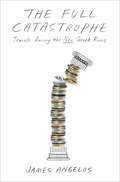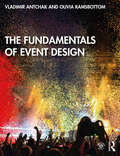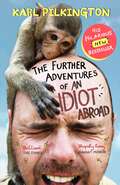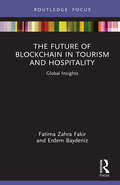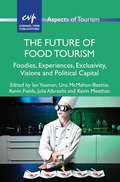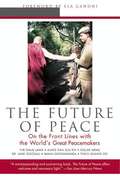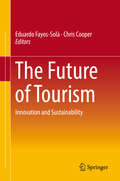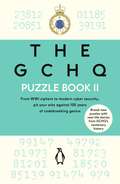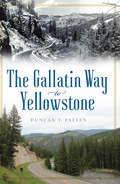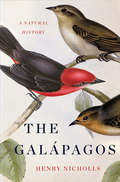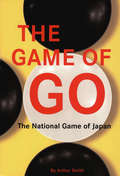- Table View
- List View
The Franco-Prussian War, 1870–1871: Touring the Sedan Campaign (Battleground 1870–1871)
by Maarten Otte&“Masterfully written . . . This series provides the enthusiast and historian with volumes in which history is combined with tourism on the battlefields.&” —On the Old Barbed Wire In 1870 France embarked on a war with Prussia and her allied German states that was to be a complete disaster. For Napoleon III, after his ignominious surrender with thousands of his troops from the Army of the Rhine and the Army of Châlons, it meant his abdication and exile. For France it resulted in the humiliation of her army, a bitter civil war in Paris, the loss of two Provinces (Alsace and Lorraine) and a heavy indemnity. Maarten Otte provides background chapters to place the lead up to the war and the issues that were involved; he describes the makeup of the opposing armies and some of their principal commanders. The Sedan Campaign was fought over a relatively small area and the locations of some of the key battles have changed little, though some of those near the built-up areas, such as Sedan itself, require some imagination. After the war several German regiments erected monuments and a surprising number remain today, often hidden away in isolated fields and copses. Several communal cemeteries have a number of German graves. Perhaps one of the most macabre of these is the ossuary in Bazeilles, where the visitor is able to see skeletons that still have shreds of uniform and footwear on them. Sedan was also a focus of the most recent and bloody western European wars, and a notable feature of this battlefield is to see memorials to the conflicts of the twentieth century—the Great War and the Second World War.
The Franconia Gateway
by Bruce D. HealdOf the several entrances to the White Mountains, none is more majestic than the Franconia Gateway. The gateway begins in the valley of the Pemigewasset River and reaches through broad meadows, between jagged mountains, alongside quiet pools and cascades of sparkling water, into the wilderness of Franconia Notch and beyond. Altogether, this region contains more historical secrets and hidden treasures than any other part of the White Mountains.The Franconia Gateway opens the way from a new perspective. With nearly one hundred fifty breathtaking views and fascinating stories, this history and guide leads from lore of the Native Americans, explorers, and early entrepreneurs to the logging boom years and the subsequent preservation era on to the days of the artists and poets and, ultimately, the tourists. The journey progresses through the communities of Plymouth, Campton, Thornton, Waterville Valley, Woodstock, and Franconia, and includes all the wonder and mystery of sites such as the Lost River, the Flume, and the Old Man of the Mountain.
The Frangipani Tree Mystery (Crown Colony #1)
by Ovidia YuFirst in a delightfully charming crime series set in 1930s Singapore, introducing amateur sleuth Su Lin, a local girl stepping in as governess for the Acting Governor of Singapore.1936 in the Crown Colony of Singapore, and the British abdication crisis and rising Japanese threat seem very far away. When the Irish nanny looking after Acting Governor Palin's daughter dies suddenly - and in mysterious circumstances - mission school-educated local girl Su Lin - an aspiring journalist trying to escape an arranged marriage - is invited to take her place. But then another murder at the residence occurs and it seems very likely that a killer is stalking the corridors of Government House. It now takes all Su Lin's traditional skills and intelligence to help British-born Chief Inspector Thomas LeFroy solve the murders - and escape with her own life.'Simply glorious. Every nook and cranny of 1930s Singapore is brought richly to life, without ever getting in the way of a classic puzzle plot. But what's a setting without a jewel? Chen Su Lin is a true gem. Her slyly witty voice and her admirable, sometimes heartbreaking, practicality make her the most beguiling narrator heroine I've met in a long while.' Catriona McPherson'Charming and fascinating with great authentic feel. Ovidia Yu's teenage Chinese sleuth gives us an insight into a very different culture and time. This book is exactly why I love historical novels.' Rhys Bowen
The Frangipani Tree Mystery (Crown Colony)
by Ovidia YuFirst in a delightfully charming crime series set in 1930s Singapore, introducing amateur sleuth Su Lin, a local girl stepping in as governess for the Acting Governor of Singapore.1936 in the Crown Colony of Singapore, and the British abdication crisis and rising Japanese threat seem very far away. When the Irish nanny looking after Acting Governor Palin's daughter dies suddenly - and in mysterious circumstances - mission school-educated local girl Su Lin - an aspiring journalist trying to escape an arranged marriage - is invited to take her place. But then another murder at the residence occurs and it seems very likely that a killer is stalking the corridors of Government House. It now takes all Su Lin's traditional skills and intelligence to help British-born Chief Inspector Thomas LeFroy solve the murders - and escape with her own life.'Simply glorious. Every nook and cranny of 1930s Singapore is brought richly to life, without ever getting in the way of a classic puzzle plot. But what's a setting without a jewel? Chen Su Lin is a true gem. Her slyly witty voice and her admirable, sometimes heartbreaking, practicality make her the most beguiling narrator heroine I've met in a long while.' Catriona McPherson'Charming and fascinating with great authentic feel. Ovidia Yu's teenage Chinese sleuth gives us an insight into a very different culture and time. This book is exactly why I love historical novels.' Rhys Bowen
The Franklin Conspiracy: An Astonishing Solution to the Lost Arctic Expedition
by John Robert Colombo Jeffrey Blair LattaThe Franklin Conspiracy is an absorbing account of the single most enigmatic event in Canadian history. In 1845, two British Royal Navy ships, the Erebus and the Terror, commanded by Sir John Franklin, entered the Canadian Arctic in search of the Northwest Passage. Neither ship returned. A fifteen-year search uncovered evidence of unparalleled disaster, but to this day no one knows exactly how the 129 men of the Franklin Expedition met their deaths. Although the expedition did not run out of food, there is clear evidence of cannibalism. The ships carried two hundred message cylinders with them, yet failed to leave records. Stranger still, an earlier explorer, Thomas Simpson, was reputedly murdered for the "secret of the Northwest Passage." What was this "secret"? The Franklin Conspiracy is an exhaustively researched, compellingly reasoned answer to that question. The result is a shocking saga of conspiracy, cover-up, and unbelievable secrets the.
The French Art of Living Well: Finding Joie de Vivre in the Everyday World
by Cathy YandellIn the tradition of Bringing up Bebe and French Toast, Cathy Yandell's The French Art of Living Well is a delightful look at French culture, from literature to cuisine to humor and more, showing how the French have captured that magic elixir known as joie de vivre.What is joie de vivre, and why is it a fundamentally French concept?In search of those ineffable qualities that make up the joy of living, this lively book takes readers on a voyage to France through forays into literature, history, and culture. How does art contribute to daily life? Why is cuisine such a central part of French existence? Why are the French more physical than many other cultures? How do French attitudes toward time speak volumes about their sense of pleasure and celebration? And finally, to what extent is this zest for life exportable? These and other questions give way to a dynamic sketch of French life today.Peppered with anecdotes and humor, this book uncovers some of the secrets of the celebrated French art of living well. Drawing from her years of living in France as a student, professor, and mother, Yandell crafts an honest and profound appraisal of French culture and how la joie de vivre can be developed in anyone’s life.
The French Ingredient: Making a Life in Paris One Lesson at a Time; A Memoir
by Jane BertchThe inspiring and delicious memoir of an American woman who had the gall to open a cooking school in Paris—a true story of triumphing over French naysayers and falling in love with a city along the way&“An engaging, multilayered story of a woman navigating innumerable cultural differences to build a life in Paris and create her dream: to establish a French cooking school.&”—David Lebovitz, author of My Paris KitchenWhen Jane Bertch was seventeen, her mother took her on a graduation trip to Paris. Thrilled to use her high school French, Jane found her halting attempts greeted with withering condescension by every waiter and shopkeeper she encountered. At the end of the trip, she vowed she would never return.Yet a decade later she found herself back in Paris, transferred there by the American bank she worked for. She became fluent in the language and excelled in her new position. But she had a different dream: to start a cooking school for foreigners like her, who wanted to take a few classes in French cuisine in a friendly setting, then bring their new skills to their kitchens back home. Predictably, Jane faced the skeptical French—how dare an American banker start a cooking school in Paris?—as well as real-estate nightmares, and a long struggle to find and attract clients.Thanks to Jane&’s perseverance, La Cuisine Paris opened in 2009. Now the school is thriving, welcoming international visitors to come in and knead dough, whisk bechamel, whip meringue, and learn the care, precision, patience, and beauty involved in French cooking. The French Ingredient is the story of a young female entrepreneur building a life in a city and culture she grew to love. As she established her school, Jane learned how to charm, how to project confidence, and how to give it right back to rude waiters. Having finally made peace with the city she swore to never revisit, she now offers a love letter to France, and a master class in Parisian cooking—and living.
The French Travelmate
by Lexus Sandrine FrançoisThe French Travelmate phrasebook and dictionary gives you a detailed yet easy-to-use A to Z list of English words and phrases with French translations for quick-find reference. There are more than 3500 words and phrases, and the French translations come together with an easy-to-read pronunciation guide. Tap a hyperlink (there are hundreds of them) to go to special sections: travel tips about being in France; basic language notes; typical French replies to your French questions; conversion tables. These are features which make the Travelmate the must-have ebook French phrasebook download for the traveller who wants to really communicate. The French Travelmate phrasebook and dictionary also gives you a detailed French menu reader of over 500 items and a dictionary section with translations of over 300 common French signs and notices. This is the little book that's a big help. And a joined-up language experience.
The French in London: From William the Conqueror to Charles de Gaulle
by Emily Read Isabelle Janvrin Catherine RawlinsonEver since 1066 there has been a substantial French presence in London. It is now said to be the sixth most populous French city and this book illustrates, explains, and exposes how this came about over more than a 1000 years. Full of individual stories and overlooked details covering a common history, from William the Conqueror to Charles de Gaulle.
The Fresh and the Salt: The Story of the Solway
by Ann Lingard“Beautiful, intensely visual prose, born from deep intimacy with subtle borderlands: land and sea, England and Scotland, people and environments.” —David Gange, author of The Frayed Atlantic EdgeFirths and estuaries are liminal places, where land meets sea and tides meet freshwater. Their unique ecosystems support a huge range of marine and other wildlife: human activity too is profoundly influenced by their waters and shores.The Solway Firth—the crooked finger of water that both unites and divides Scotland and England—is a beautiful yet unpredictable place and one of the least-industrialized natural large estuaries in Europe. Its history, geology and turbulent character have long affected the way its inhabitants, both human and non-human, have learnt to live along and within its ever-changing margins.“Lingard’s scientific knowledge of the area and its multitudinous inhabitants [is] delivered in riveting prose. This is deep and beautiful natural history writing.” —BBC Countryfile Magazine“Like a hungry gull, Ann Lingard explores her beloved Solway shoreline for every living detail that catches her eye. In so doing she has created a portrait of this nation-cleaving water that is as broad and deep as the estuary itself.” —Mark Cocker, author of Birds & People“A kaleidoscopic portrait of the borders of the land.” —Cumbria Life“Lingard writes vividly about this estuary . . . an excellent point of reference for locals, visitors and for those simply intrigued by this lesser-known corner of Scotland.” —Scottish Field
The Friendship Highway: Two Journeys in Tibet
by Charlie CarrollAfter a twenty-year obsession, Charlie finally experienced Tibet in all its heartbreaking beauty. At the end of the road known as the Friendship Highway, he met Tibetan-born Lobsang who recounts the extraordinary story of how he fled the volatile region over the Himalayas, on foot, as a child in 1989, but was called back to Tibet by love.
The Frontier in American History
by Frederick Jackson TurnerA fascinating exploration of American identity by one of the most influential historians and thinkers of the twentieth century According to Frederick Jackson Turner, the distinct qualities of the American character are inseparable from the idea of the frontier. One of the nation's most influential historians, Turner sets forth his "frontier thesis" in the eight brilliant, enlightening, and provocative essays that make up his seminal work, The Frontier in American History--a book which profoundly altered the way Americans viewed themselves. Disputing the traditionally held emphasis on European cultural influences, Turner argues that the American frontier fostered self-reliance, optimism, ingenuity, individualism, restlessness, materialism, and democratic ideals--traits that collectively shaped the national character. His groundbreaking work continues to influence American culture, politics, and history more than eighty years after it was first published.
The Frozen Thames
by Helen HumphreysA groundbreaking, genre-bending new work from one of Canada’s most respected writers. In its long history, the River Thames has frozen solid forty times. These are the stories of that frozen river. And so opens one of the most breathtaking and original works being published this season. The Frozen Thamescontains forty vignettes based on events that actually took place each time the river froze between 1142 and 1895. Like a photograph captures a moment, etching it forever on the consciousness, so does Humphreys’ achingly beautiful prose. She deftly draws us into these intimate moments, transporting us through time so that we believe ourselves observers of the events portrayed. Whether it’s Queen Matilda trying to escape her besieged castle in a snowstorm, or lovers meeting on the frozen river in the plague years; whether it’s a simple farmer persuading his oxen the ice is safe, or Queen Bess discovering the rare privacy afforded by the ice-covered Thames, the moments are fleeting and transformative for the characters — and for us, too. Stunningly designed and illustrated throughout with full-colour period art,The Frozen Thamesis a triumph. From the Hardcover edition.
The Full Catastrophe
by James AngelosA transporting, good-humored, and revealing account of Greece's dire troubles, reported from the mountain villages, idyllic islands, and hardscrabble streets that define the country todayIn recent years, small Greece, often associated with ancient philosophers and marble ruins, whitewashed villages and cerulean seas, has been at the center of a debt crisis that has sown economic and social ruin, spurred panic in international markets, and tested Europe's decades-old project of forging a closer union. In The Full Catastrophe, James Angelos makes sense of contrasting images of Greece, a nation both romanticized for its classical past and castigated for its dysfunctional present. With vivid character-driven narratives and engaging reporting that offers an immersive sense of place, he brings to life some of the causes of the country's financial collapse, and examines the changes, some hopeful and others deeply worrisome, emerging in its aftermath. A small rebellion against tax authorities breaks out on a normally serene Aegean island. A mayor from a bucolic, northern Greek village is gunned down by the municipal treasurer. An aging, leftist hero of the Second World War fights to win compensation from Germany for the wartime occupation. A once marginal group of neo-Nazis rises to political prominence out of a ramshackle Athens neighborhood. The Full Catastrophe goes beyond the transient coverage in the daily headlines to deliver an enduring and absorbing portrait of modern Greece.From the Hardcover edition.
The Fundamentals of Event Design
by Vladimir Antchak Olivia RamsbottomThe Fundamentals of Event Design aims to rethink current approaches to event design and production. The textbook explores the relationship between event design and multiple visitor experiences, as well as interactivity, motivation, sensory stimuli and co-creative participation. Structured around the key phases of event design, the book covers all the critical dimensions of event concepting, atmospherics, the application of interactive technologies, project management, team leadership, creative marketing and sustainable production. The concepts of authenticity, creativity, co-creation, imagineering and storytelling are discussed throughout, and practical step-by-step guidance is provided on how to create and deliver unique and memorable events. The chapters include industry voices offering real-life insight from leading international event practitioners and individual and/or team assignments to stimulate learners’ creativity, visualisation and problem solving. This is the first textbook in event design that integrates areas of anthropology, social psychology, management, marketing, graphic design and interactivity. Focusing on bringing theory into practice, this is essential reading for all Events Management students.
The Further Adventures of an Idiot Abroad
by Karl PilkingtonA new book on the travails of travel by “the funniest man on the planet” (Spectator).Why on earth would anybody want to run with the bulls in Pamplona? Go “storm chasing” through Tornado Alley? Jump out of a plane? Have lunch with the queen or touch hands with the pope? The Further Adventures of An Idiot Abroad is a fresh take on the bucket-list mentality from television star Karl Pilkington, renowned for his comedic collaborations with Ricky Gervais and Stephen Merchant.While he’s done some dumb things like putting sausages in a toaster, Karl has never been one for danger. But Ricky and Stephen managed to convince him to take on at least a few challenges, and in this hilarious and strangely inspiring book, Karl recounts brilliant stories of his adventures in Alaska, in Siberia, on a South Sea island, inside a gigantic rubber ball trying not to throw up, and more; states his opinions about what other people aspire to do with their lives; and shares his hard-won certainty that coming back home is the best thing about going away in the first place.
The Future of Blockchain in Tourism and Hospitality: Global Insights (Routledge Focus on Tourism and Hospitality)
by Fatima Zahra Fakir Erdem BaydenizThis timely and innovative book presents a critical exploration of how blockchain technologies may be useful in enhancing the sustainability, viability, and social responsibility of the tourism and hospitality sectors. A key component of many contemporary financial structures and exchanges globally, this volume explores the international scope and application of blockchain within the tourism and hospitality industries, including varied and illustrative case studies from the vibrant streets of Tokyo to the serene landscapes of New Zealand. This book traverses diverse destinations to showcase the transformative power of blockchain in shaping travel experience, including insights into booking platforms, payment systems, loyalty programs, smart contracts, automation, and security issues. Strategic guidance for leveraging blockchain to address industry-specific challenges, maximize emerging opportunities, and promote transparency, trust, and sustainability is provided throughout.This volume is a pivotal resource for students, scholars, and academics with an interest in digital innovation and analytics, new technologies in tourism and management, big data management and contemporary issues in marketing and management. The book may also be of professional interest to tourism and hospitality managers, marketers, consultants, and advisors.
The Future of Events & Festivals (Routledge Advances in Event Research Series)
by Karen A. Smith Ian Yeoman Elisa Backer Martin Robertson Una McMahon-BeattieThe growth of events and festivals has been significant over the last decade and a wide range of skills are essential to ensure those events are successful. This requirement has been instrumental in stimulating the creation of more tertiary education opportunities to develop events management knowledge. As the discipline develops, knowledge requires direction in order to understand the changing advances in society. This is the first book to take a futures approach to understanding event management. A systematic and pattern-based understanding is used to determine the likelihood of future events and trends. Using blue skies scenarios to provide a vision of the future of events, not only capturing how the events industry is changing but also important issues that will affect events now as well as the future. Chapters include analysis of sustainability, security, impacts of social media, design at both mega event and community level and review a good range of different types of events from varying geographical regions. A final section captures the contributions of each chapter through the formation of a conceptual map for a future research agenda. Written by leading academics in the field, this ground breaking book will be a valuable reference point for educators, researchers and industry professionals.
The Future of Food Tourism
by Ian Yeoman Una Mcmahon-BeattieThis book presents a systematic and pattern-based explanation of food tourism, focusing on how and why change could occur and what the implications could be. In the future will food tourism involve food grown in the laboratory or a more authentic experience associated with place and history? The book's approach to the future has focused on explanation; the contributors look for the causes, trends and theoretical concepts that explain change, thus attempting to justify and explore the future. Scenarios are used to explore alternative futures and the book examines the implications for the future of food tourism and highlights future research avenues. This book is primarily aimed at postgraduate students and researchers in the field of tourism studies.
The Future of Peace
by Scott HuntIn this illuminating journey around the globe, Scott A. Hunt takes us face to face with true heroes including: the Dalai Lama; the famed dissident of Burma, Aung San Suu Kyi; and the activist who brought peace to Latin America, Oscar Arias of Costa Rica, who share their historic struggles and show us how to find optimism in the face of anguish, and compassion in the place of animosity. What does it mean to fight for peace? From the riotous streets in Burma to a prison cell in Vietnam, from the bombed-out streets of Belfast to the refugee camps of Palestine, Scott A. Hunt travels across the globe, often under arduous conditions, to report from the major battles that shaped and continue to shape our world. Recounting histories that were not taught in school, and uncovering lessons which may have been brushed aside, Scott A. Hunt coaxes out in intimate conversations staggering stories from Vietnam's leading dissident Thich Quang Do, famed primate specialist and humanitarian Dr. Jane Goodall, Cambodia's Supreme Patriarch Maha Ghosananda, Ireland's Nobel Peace Laureate John Hume and other great leaders who have battled to end the brutality against the people and causes they cherish. In the end, The Future of Peace reveals what it means to remain steadfast to a vision of compassion, to be a leader, and to preserve peace in our own day-to-day lives. The Future of Peace is an extraordinary investigation that offers far-ranging insights and invaluable lessons - a book that changes the way we think about the world and our responsibility toward one another.
The Future of Tourism: Innovation And Sustainability
by Chris Cooper Eduardo Fayos-SolàThis book presents the foundations for the future of tourism in a structured and detailed format. The who-is-who of tourism intelligence has collaborated to present a definitive blueprint for tourism reflecting the role of science, market institutions, and governance in its innovation and sustainability. The book adopts a comprehensive approach, exploring recent research and the latest developments in practice to inform the reader about instruments and actions that can shape a successful future for tourism. Broad in scope, the book incorporates the perspectives of leading tourism academics, as well as the views of tourism entrepreneurs, destination managers, government officials, and civil leaders. The book is divided into three parts, the first of which addresses the scientific facets of innovation, analyzing the challenges and opportunities that technology provides for organic and disruptive developments in tourism, which will shape its future. In turn, the second part examines socio-cultural paradigms – with a view to dismantling traditional barriers to innovation. It also explores the role of heritage and the ethics of inclusiveness as drivers for sustainable tourism. The third part investigates new ways and means in governance and policy making for tourism. It introduces advances such as strategic positioning, symbiotic partnerships, and innovative management, and closes by presenting governance frameworks for an inclusive and sustainable future of tourism.
The GCHQ Puzzle Book II
by GCHQTrain your brain with these fiendishly difficult puzzles, the perfect companion for anyone wanting to keep their mind busy'Fiendishly tricky' Daily MailWith their first bestselling book, The GCHQ Puzzle Book, the UK's intelligence and security experts tested us with puzzles, codes and real-life entrance tests from their archives.Now, they are back with a NEW collection of head-scratching, mind-boggling and brain-bending puzzles that will leave you pondering for hours.For those who often found themselves stumped with the first book, The GCHQ Puzzle Book 2 offers even more starter puzzles to get those brains warmed up. Puzzle aficionados needn't worry though, as there is also an 'Even Harder' section to test everyone to their limits . . .Not only that, but in celebration of GCHQ's centenary, the puzzles in this new book sit alongside stories, facts and photos from the organisation's first 100 years at the heart of the nation's security. From the Government Code & Cipher School, to Bletchley Park, through to protecting against cyberattacks, the security of our country is in the hands of GCHQ. With this book, you get exclusive snapshots into the organisation that keeps us all safe.Train your brain to compete with the smartest in the country with this stimulating book of puzzles. If you haven't yet tested yourself with the first instalment of The GCHQ Puzzle Book, check it out now!'This is the perfect gift to fuel his ludicrous presumption that he could have definitely been a spy - even better if he's already dog-eared the first version' Huffington Post
The Gallatin Way to Yellowstone (Transportation)
by Duncan T. PattenThe Gallatin Way, a picturesque route heading south through the canyon to the west gate of Yellowstone, boasts a history covering more than a century of exploration, homesteading and development. Early pioneers and adventurers endured a rugged and unforgiving terrain where today's travelers speed along a modern highway. One might expect to see dramatic shifts, yet little change is evident in some areas, while others teem with contemporary luxuries. Pairing historic and modern photography of the same locations, Duncan T. Patten retraces the marvel of this iconic thoroughfare.
The Galápagos: A Natural History
by Henry NichollsThe natural and human history of the Galapagos Islands--beloved vacation spot, fiery volcanic chain, and one of the critical sites in the history of science The Galapagos were once known to the sailors and pirates who encountered them as Las Encantadas: the enchanted islands, home to exotic creatures and dramatic volcanic scenery. In The Galapagos, science writer Henry Nicholls offers a lively natural and human history of the archipelago, charting its evolution from deserted wilderness to scientific resource (made famous by Charles Darwin) and global ecotourism hot spot. He describes the island chain’s fiery geological origins as well as the long history of human interaction with it, and draws vivid portraits of the Galapagos’ diverse life forms, capturing its awe-inspiring landscapes, its understated flora, its stunning wildlife and, crucially, the origin of new species. Finally, he considers the immense challenges facing the islands and what lies ahead. Nicholls shows that what happens in the Galapagos is not merely an isolated concern, but reflects the future of our species’ relationship with nature--and the fate of our planet.
The Game of Go
by Arthur SmithPassing from China, where it was developed over 3,000 years ago, to Japan, where it today commands a vast and enthusiastic following, Go is probably the oldest intellectual game in the world. Similar to chess, it leaves nothing to chance, requiring great strategy and carefully plotted campaigns to achieve an impregnable position, block enemies from lines of communication and win a series of battles. To penetrate this complicated, challenging game requires a great guide- and this is it. Unsurpassable in its clarity and comprehensiveness, The Game of Go has been the classic guide to the game since it was first published in 1956.
